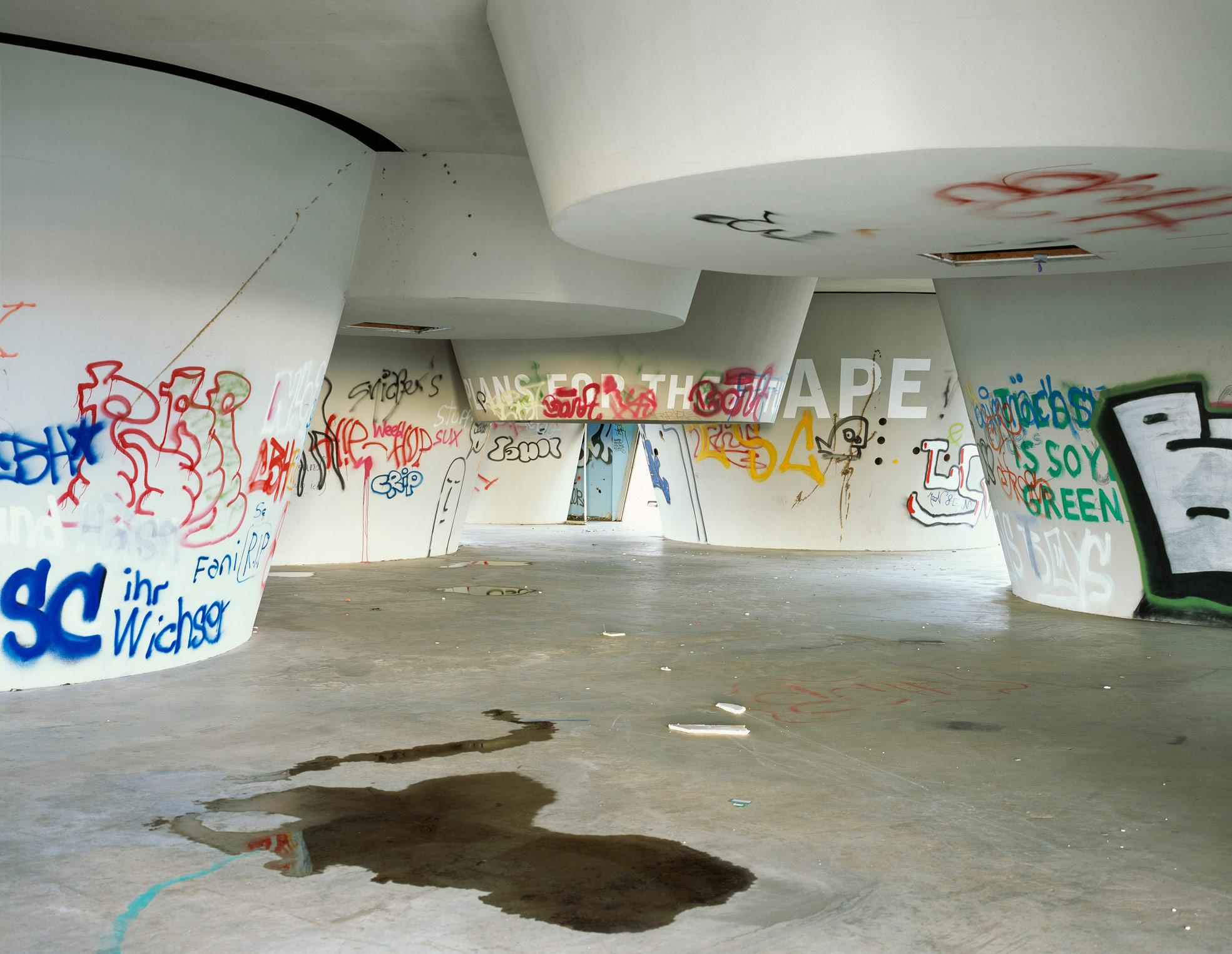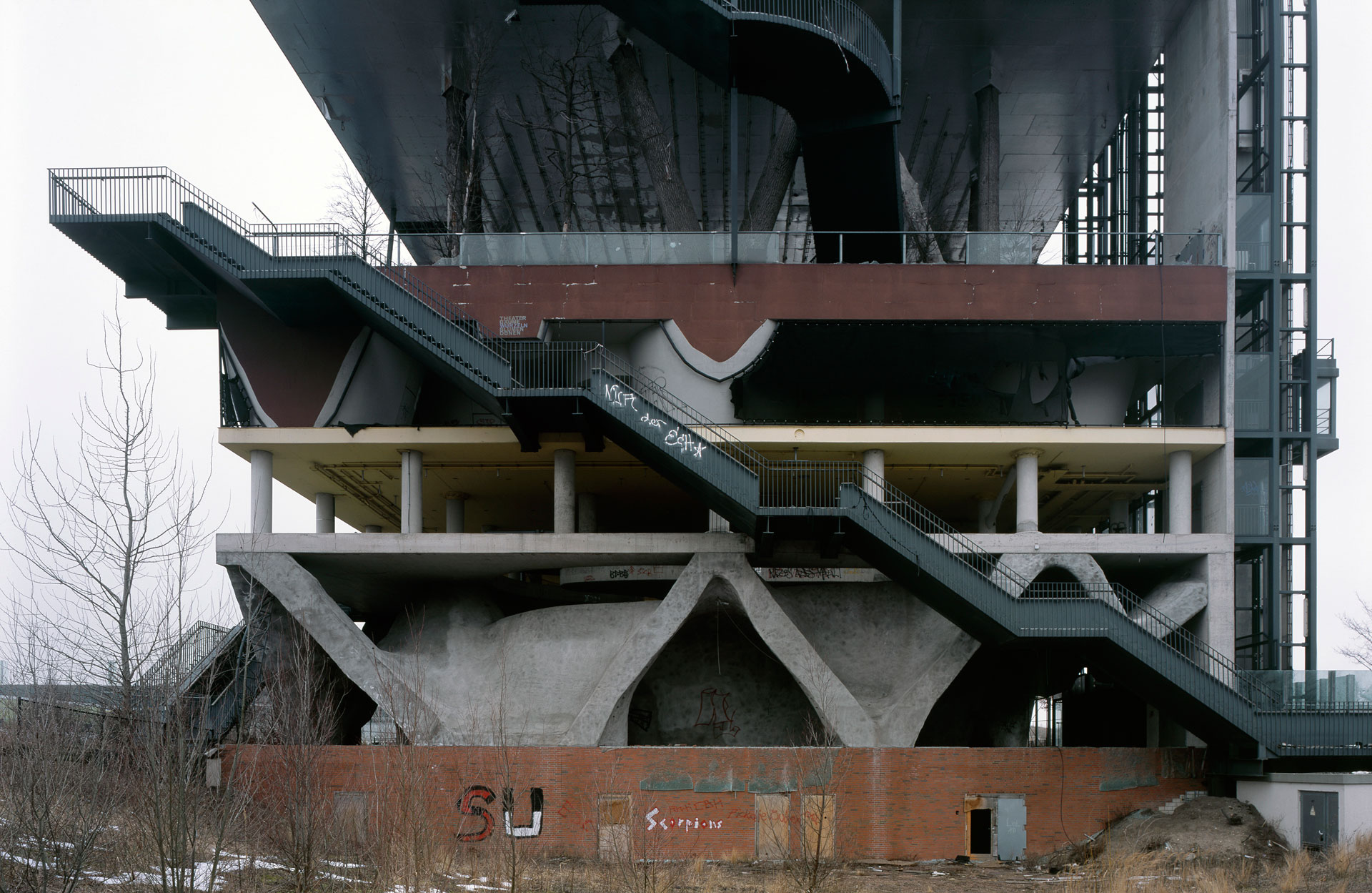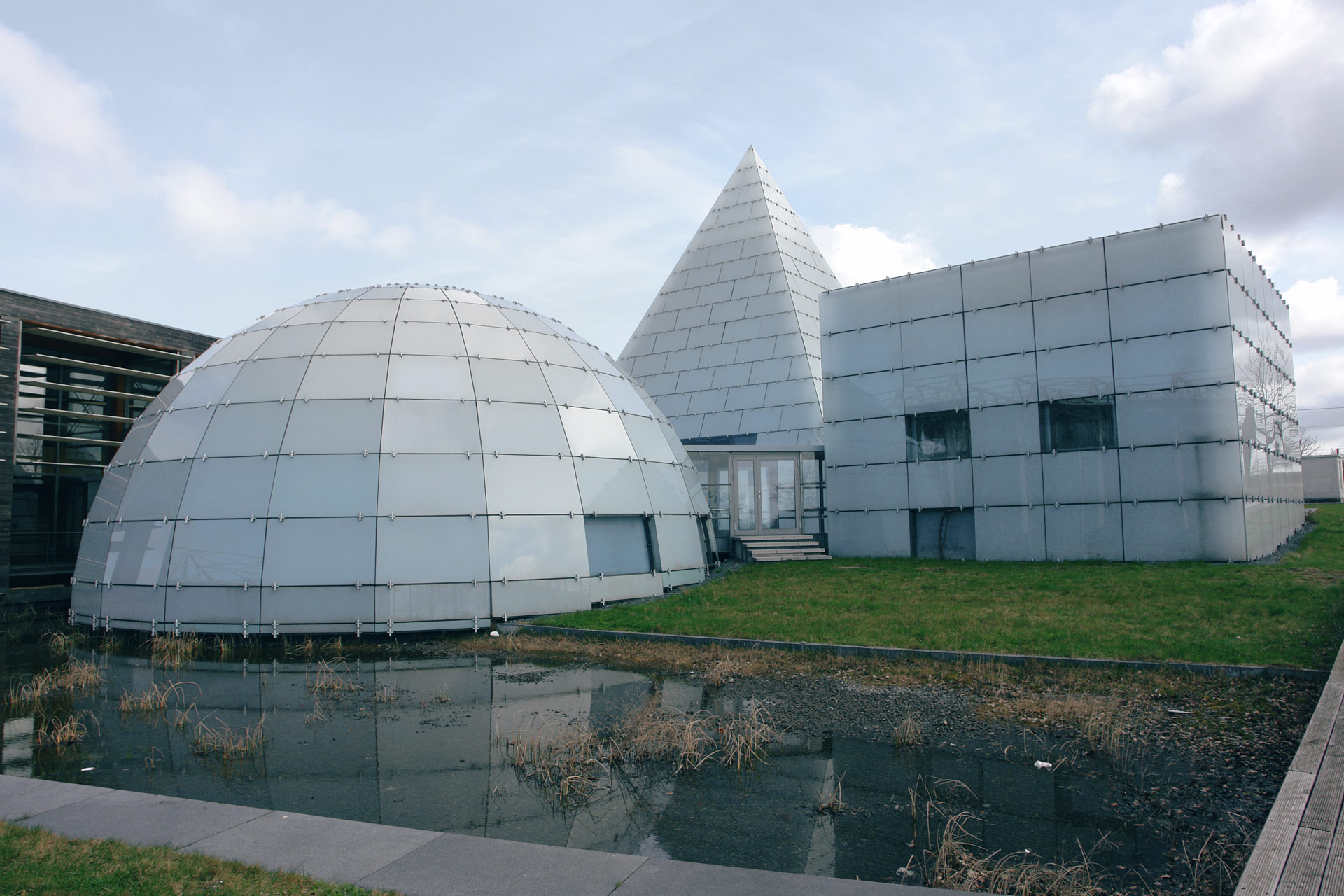-


Hanover Expo, 2000
By Rob Wilson
View of MVRDV's Dutch Pavilion at the Hanover Expo site, as it looks today. (Photo: Ives Maes)
-
What makes a successful Expo? Financially and in terms of visitor numbers, Expo 2000 was a flop but it scored when it came to recycling after the event. Rob Wilson looks beyond the bling towards cultural values, infrastructural advantages and small footprints.

Just as abandoned fairgrounds often serve well as creepy settings for horror films, the derelict bones of old expos look particularly macabre: decayed carcasses of once spectacular structures built to fizz with positivity and ideas for the future. One example of this is the MVRDV-designed Dutch Pavilion from Expo 2000 in Hanover, Germany, once star of the show, now a forlorn, rotting shell.
With its theme of “Holland Creates Space”, responding to the Expo’s one of “Humankind, Nature, Technology”, the Dutch pavilion was a 36-metre-high tower of six stacked landscapes symbolising and demonstrating how to maximise the use of limited space. Visitors moved up through its tulip fields to a small lake at the top, where windmills ran turbines powering the structure.
Originally the plan post-Expo had been to dismantle and re-erect the building in the Netherlands, but this was deemed too costly. With even demolition proving expensive, the pavilion was apparently given away with a cash dowry to a man who promised to give it a second lease of life. Later this recipient tried unsuccessfully to sell the pavilion on eBay, and now it is owned by his son, seemingly too cash-strapped to either renovate or demolish it.
With a touch of schadenfreude, the pavilion’s remains might seem a fitting monument to misplaced millennial optimism and the symbolic legacy of Expo 2000, widely seen as a relative failure at the time: only 18 million tickets were sold against a projected 40 million (compared to the 64 million in Osaka in 1970 or Shanghai Expo 2010’s 73 million) and it ended with a financial deficit of some 3,900 million deutschmarks. But the story of ambitious legacy intentions before the event, later overtaken by any ad hoc needs-must solutions going, is a familiar one post-Expo. -

MVRDV’s Dutch Pavilion interior today. (Photo: Ives Maes)
MVRDV’s Dutch Pavilion exterior today. (Photo: Hagen Stier) -
Indeed Expo 2000 was actually one of the more successful iterations when it came to recycling its old pavilions. Whilst most were demolished, the Belgian Pavilion for instance is now known as the Peppermint Pavilion, housing an event space, recording studio and record company. Meanwhile the Mexican Pavilion popped up in Braunschweig, as the library for the University of the Arts there, while the Nepalese Pavilion was resurrected at the centre of a botanical garden in Bavaria.
In general, the hoped-for legacy of an expo can be roughly grouped into three types. Most importantly, yet ephemerally, is that sense of you-had-to-be-there – both in an individual and folk-memory sense. The feel good factor for those who attend is naturally a key outcome for the countries or corporations bankrolling Expos; for World’s Fairs have always been exercises in either national or commercial soft-power – beaming out messages to their citizens and consumers to influence their future thinking, voting and buying habits»The decayed carcasses of once spectacular structures built to fizz with positivity and ideas for the future«
– be it a cool-contemporary national image for the Weimar Republic, offered by Mies van der Rohe’s German Pavilion in Barcelona in 1929, or the turn on, tune in, drop out, and er, drink Pepsi message of the Pepsi Pavilion designed by E.A.T. for the Osaka Expo in 1970.
Secondly, beyond the spin, Expos have often initiated or promoted actual technical and cultural shifts, either by allowing the space or license to attempt some daring new engineering feat – the moving walkways at the 1900 Paris World Fair, the unprecedented iron girder structure of the Eiffel Tower in 1889 – or by providing a forum where a new visual trend or style can coalesce. The so-called “White City” of Chicago’s 1893 Columbian Exposition set off a global neo-classical revival, while the 1925 Exposition Internationale des Arts Décoratifs et Industriels Modernes in Paris lent its name to the Art Deco movement. -

The cluster of structures which once served as the Danish Pavilion. (Photo: Flickr/Peter Shacky)
-
»The conundrum for the contemporary Expo is how to deliver a sustainable legacy message from what is, by its nature, a one-off wasteful event«
The former Lithuanian pavilion. (Photo: Hagen Stier)
-
The third type of legacy is the actual, physical, urban knock-on effect for a host city; the seeding of urban expansion or new neighbourhoods through improved infrastructure or through showcasing new models for living: as at the Montreal Expo ’67, with its new Concorde Bridge, monorail and Habitat housing complex, or the laying out of the new EUR district for the (cancelled) 1942 Esposizione Universale in Rome.
Those individual buildings or structures that transcend their Expo genesis and make it to a useful afterlife are usually ones that successfully combine aspects of all these types of legacy, acting as memorable icons, representing technical advances or providing practical future facilities. Paralleling Robert Venturi and Denise Scott Brown’s observations in Learning from Las Vegas, on that more permanent urban encampment of signs and showstopper attractions, these generally fall into two types: ducks or decorated sheds – structures that symbolically carry a message or embody a brand, easily transferable from Expo to city (usually tall and distinctively profiled e.g. the Atomium in Brussels) or buildings that offer ultra-flexible re-use (usually vast and shed-like e.g. the Grand Palais in Paris).
The 1851 Great Exhibition, the first Expo, still remains the model to beat in terms of delivering on all legacy fronts. It acted as a condenser for Britain’s image as the workshop of the world and transmitted powerful British Empire PR, not only to its six million visitors but also as a worldwide news event: witness all the other countries that jumped to emulate it. It also turned in a healthy profit, which was ploughed back into a new museums’ quarter in Kensington. The innovative cast iron and plate glass structure of the Crystal Palace, designed by Joseph Paxton, both distinctive symbolic duck as well as enormous decorated shed, was rebuilt in extended form in South London, providing a capacious flexible venue for over 80 years until it burned down in 1936, and simultaneously becoming the generator for a whole new London suburb around it.
That all this only happened on the back of the single-minded power trip of the original event is easily critiqued now for its unselfconsciousness nationalism and misplaced belief in linear progress, fuelled by commerce and manufacturing. But this remains the conundrum for the contemporary, “sustainable” Expo of today: how to celebrate human ingenuity yet replace the passion and spectacle generated by national or commercial rivalry in order to attract visitors, and how to deliver a sustainable legacy message from what is, by its nature, a one-off wasteful event. For aside from the über-duck or über-shed exceptions, the appropriate legacy, as with any travelling fair, should be an empty camp site, containing nothing more than the carefully kicked-over embers of a fire. I
-
Search
-
FIND PRODUCTS
PRODUCT GROUP
- Building Materials
- Building Panels
- Building technology
- Façade
- Fittings
- Heating, Cooling, Ventilation
- Interior
- Roof
- Sanitary facilities
MANUFACTURER
- 3A Composites
- Alape
- Armstrong
- Caparol
- Eternit
- FSB
- Gira
- Hagemeister
- JUNG
- Kaldewei
- Lamberts
- Leicht
- Solarlux
- Steininger Designers
- Stiebel Eltron
- Velux
- Warema
- Wilkhahn
-
Follow Us
Tumblr
New and existing Tumblr users can connect with uncube and share our visual diary.
»Architectural interpretations accepted without reflection could obscure the search for signs of a true nature and a higher order.«
Louis Isadore Kahn
Keyboard Shortcuts
- Supermenu
- Skip Articles
- Turn Pages
- Contents


